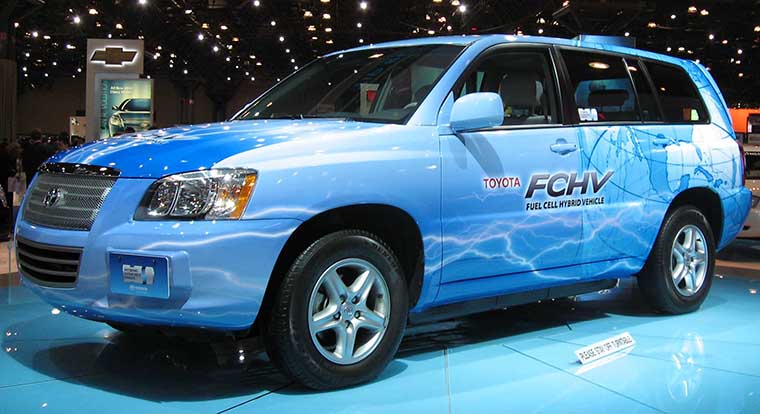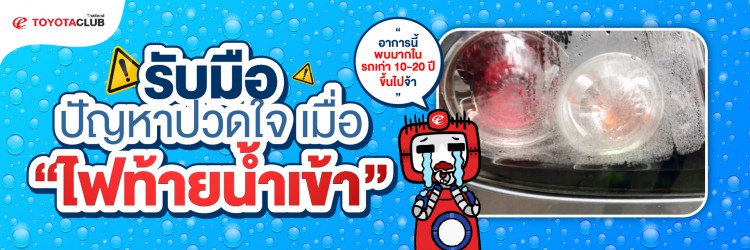

Toyota FCHV
The Toyota FCHV is a current hybrid hydrogen fuel cell vehicle development programme, which had a limited commercial launch in the USA and Japan in 2002.
"FCHV" stands for "Fuel Cell Hybrid Vehicle". A number of prototypes have been produced, up to the latest FCHV-adv ("advanced"). The FCHV designs are based on the first generation Highlander SUV, although a bus version is also in development. The powertrain consists of a 90 kW fuel cell supplied from onboard compressed hydrogen tanks, and a nickel-metal hydride accumulator battery in parallel. Battery and fuel cell can provide power to the 90 kW driving motors either singly or together. The mechanism is very similar to the Hybrid Synergy Drive in the Toyota Prius and Toyota Auris HSD but with the fuel cell replacing the petrol internal combustion engine, thus minimising greenhouse gas emissions at point of use.
At low speeds the FCHV can run on battery alone, with a range of about 50 km (31 mi). For high performance, such as when accelerating from rest, the fuel cell and battery supply power in tandem. The battery can also charge by regenerative braking, improving overall efficiency. There are currently five generations of the FCHV, beginning with preliminary prototypes FCHV-1 (1997) and FCHV-2 (1999). The FCHV-3 was presented at the "International Symposium on Fuel-Cell Vehicles" in March 2001 in Tokyo, and the FCHV-4 was the first production version, although Toyota does not plan a full-scale commercial hydrogen fuel cell vehicle launch until around 2015.
As of 2008 the FCHV-adv was available for lease in Japan.[2] The use of the vehicles by government ministries and companies is intended to provide detailed development feedback on the FCHV performance under varied driving conditions.
In 2007 a FCHV was driven 560 km (350 mi) between Osaka and Tokyo on a single tank of hydrogen, proving that a hydrogen vehicle could compete with conventional vehicles for range. In August 2009, Toyota USA announced an estimated FCHV-adv range of 690 km (430 mi) from a 6 kg (13 lb) tank of hydrogen, based on a 331.5-mile (533.5 km) test trip in "real-world" conditions between Torrance and San Diego, California.
Hydrogen storage
The 700 Bar (10000 PSI) hydrogen tanks holds 156 liters - enough fuel for a range of 830 kilometers (520 mi) on the Japanese 10-15 test cycle and 760 kilometers (470 mi) on the Japanese JC08 test cycle.[4] Test vehicles on the Japanese 10-15 test cycle average 22.7 kilometers per hour (14.1 mph) with a top speed of 70 kilometers per hour (43 mph).[5] Vehicles on the JC08 test cycle average 24.4 kilometers per hour (15.2 mph) and a top speed of 81.6 kilometers per hour (50.7 mph).
FCHV-BUS
The Toyota FCHV-BUS is a fuel cell bus based on the Hino Blue Ribbon City low-floor bus.
90 kW PEFC Fuel cell stack: twice
Motor: AC synchronous 80 kW twice
Hydrogen tank: Compressed hydrogen gas 35 MPa / 150 liter, five (version 2002) or seven (version 2005)
Passenger capacity: 63 (included 22 seats)
FCHV-BUS demonstrated at Toei Bus (August 2003 - December 2004) and Expo 2005. After Expo 2005, some were lent to bus fleet operators, and also demonstrated in fuel cell events. Chita Noriai (March 2006 - December 2009) as route bus in Chubu International Airport Chubu International Airport (since July 2006) as ramp bus
Meitetsu Bus (since October 2010) as route bus in Toyota City, Aichi
Airport Transport Service (since December 2010) as airport shuttle bus for Tokyo International Airport







